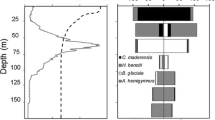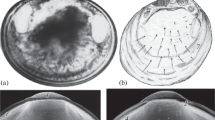Abstract
Variability and dominance of Euphausia superba Dana larval forms (Furcilia-I and Furcilia-II stages) in the plankton of the Scotia and Weddell Seas have been investigated. New forms (1′, 2″, 3″ and 1″4′) have been recorded. The dominant forms of Furcilia-I stage are proposed to represent the initial dominants. In accordance with the initial dominance, five types of larval form combinations have been established. During the initial dominance change — from 5′ to 2′, the larval form number increases. This phenomenon is due to parallel development of euphauiid larvae; it results from a developmental pathway change in the main larval mass. Such deviations are reflected in an initial dominance change. In each pathway, the larvae pass through an unequal number of moults before reaching Form 5″ (in accordance with the proposed moult scheme of Furcilia-I stage larvae). In the case of initial dominance of less-developed forms, the presence of different parallel pathways increases. As a result, the total number of larval forms present in the plankton changes, causing increased variability of the total number of larval forms. Each type of larval form combination is the result of summation of all larval forms, which derive from different developmental pathways of the larvae in different localities. The most usual developmental pathway for Euphausia superba is through Form 5′, which may, thus, be regarded as the main developmental pathway for this species. This pathway probably corresponds to optimal environment conditions for larval growth and morphogenesis with maximal synchronisation of both processes. Consequently, it may be suggested that changes in developmental pathways of larvae are connected with suboptimal environmental conditions.
Similar content being viewed by others
Literature Cited
Bary, B. M.: Note on ecology, systematics, and development of some Mysidacea and Euphausiacea (Crustacea) from New Zealand. Pacif. Sci. 10, 431–467 (1956)
Boden, B. P.: Euphausiacea of Benguela current, first survey R. R. V. “William Scoresby” March 1950. ‘Discovery’ Rep. 27, 337–376 (1955)
Broad, A. C.: The relationship between diet and larval development of Palaemonetes. Biol. Bull. mar. biol. Lab., Woods Hole 112, 162–170 (1957)
— and J. H. Hubschman: The larval development of Palaemonetes kadiakensis M. J. Rathbun in the laboratory. Trans. Am. microsc. Soc. 82, 185–197 (1963)
Costlow, J. D.: Variability in larval stages of the blue crab Callinectes sapidus. Biol. Bull. mar. biol. Lab., Woods Hole 128, 58–66 (1965)
—: Metamorphosis in Crustacea. In: Metamorphosis: a problem of developmental biology, pp 3–41. Ed. by W. Etkin and L.I. Gilbert. New York. Appleton-Century-Crofts 1968
Einarsson, H.: Euphausiacea. I. Northern species. Dana Rep. 27, 3–185 (1945)
Fraser, F.C.: On the development and distribution of the young stages of krill (Euphausia superba). ‘Discovery’ Rep. 14, 3–192 (1936)
Gopalakrishnan, K.: Developmental and growth studies of the euphausiid Nematoscelis difficilis (Crustacea) based on rearing. Bull. Scripps Instn Ocean. (New Ser.) 20, 1–87 (1973)
Giese, A.C.: Comparative physiology; annual reproductive cycles of marine invertebrates. A. Rev. Physiol. 21, 547–576 (1959)
Gurney, R.: Larvae of decapod Crustacea. Ray Soc. Publ. 129, 1–306 (1942)
—: Some notes on the development of the Euphausiacea. Proc. zool. Soc. Lond. 117, 49–64 (1947)
Heegaard, P.: The larval stages of Meganyctiphanes (Euphausiace) and some philogenetic remarks. Meddr Komm Danm. Fisk.-og Havunders. (Ser. Plankton) 5, 1–27 (1948)
—: Larval stages and growth in the decapods. Vidensk. Meddr dansk naturh. Foren. 134, 119–126 (1971)
Hubschman, J.H.: Development and function of neurosecretory sites in eyestalks of larval Palaemonetes (Decapoda, Natantia). Biol. Bull. mar. biol. Lab., Woods Hole 125, 96–113 (1963)
Lebour, M.V.: A general survey of larval euphausiids with a scheme for their identification. J. mar. biol. Ass. U.K. 14, 519–527 (1926)
Le Roux, A.: Influence de l'ablation des pédoncles oculaires sur Nyctiphanes couchii (Bell) (crustacé, euphauiacé). C. r. hebd. Séanc. Acad. Sci., Paris 276, 1317–1320 (1973a)
—: Observations sur le dévelopment larvaire de Nyctiphanes couchii (Crustacea: Euphausiacea) au laboratoire. Mar. Biol. 22, 159–166 (1973b)
Macdonald, R.: Irregular development in the larval history of Meganyctiphanes norvegica. J. mar. biol. Ass. U.K. 14, 785–794 (1927)
Mackintosh, N.A.: Life history cycle of Antarctic krill in relation to ice and water conditions. ‘Discovery’ Rep. 36, 1–94 (1972)
Marr, J.W.S.: The natural history and geography of the Antarctic krill (Euphausia superba Dana). ‘Discovery’ Rep. 32, 33–464 (1962)
Mauchline, J.: The development of Euphausiacea (Crustacea) especially that of Meganyctiphanes norvegica (M. Sars). Proc. zool. Soc. Lond. 132, 627–639 (1959)
—: The larval development of the euphausiid, Thysanoessa raschii (M. Sars). Crustaceana 9, 31–40 (1965)
—: Euphausiacea. Larvae. Rapp. P.-v.Réun. Cons.perm. int. Explor. Mer (Fiches d'identification du zooplancton) 135–137, 1–16 (1971)
— and L. R. Fisher: The biology of euphausiids. In: Advances in marine biology, Vol. 7. 1–454. Ed. by F.S. Russell and M. Yonge. London & New York: Academic Press 1969
Provenzano, A. J.: The complete larval development of the west Indian hermit crab Petrochirus diogenes (L.) reared in the laboratory. Bull. mar. Sci. Gulf Caribb. 8, 143–181 (1968)
Rustad, D.: Euphausiacea with notes on their biogeography and development. Scient. Results Norw. Antarct. Exped. 5, 1–28 (1930)
Sheard, K.: Taxonomy, distribution and development of the Euphausiacea (Crustacea). Rep. B.A.N.Z. antarct. Res. Exped. 8, 1–72 (1953)
Soulier, B.: Euphausiacés des bancs de Tierre-nueve de Nouvelle-écosse et du Golf du Maine. Revue Trav. Inst. (scient. tech.) Pêch. marit. 29, 173–190 (1965)
Snodgrass, R.E.: Crustacean metamorphosis. Smithson. misc. Collns 131, 1–78 (1956)
Zelickman, E.A.: The morphology of early larval stages of mass euphausiid species. [Russ.]. Trudy murmansk. morsk. biol. Inst. 3 (7), 23–25 (1961)
—: Some features on the family Euphausiidae (Crustacea, Euphausiacea) in neritic and oceanic area. [Russ.]. Zool. Zh. 47, 1314–1327 (1968)
Zimmer, C.: Euphausiacea. Bronn's Kl. Ordn. Tierreichs 5, 1–286 (1956)
Author information
Authors and Affiliations
Additional information
Communicated by M.E. Vinogradov, Moscow
Rights and permissions
About this article
Cite this article
Makarov, R.R. Dominance of larval forms in euphausiid (Crustacea:Eucarida) ontogenesis. Mar. Biol. 27, 93–99 (1974). https://doi.org/10.1007/BF00389061
Accepted:
Issue Date:
DOI: https://doi.org/10.1007/BF00389061




